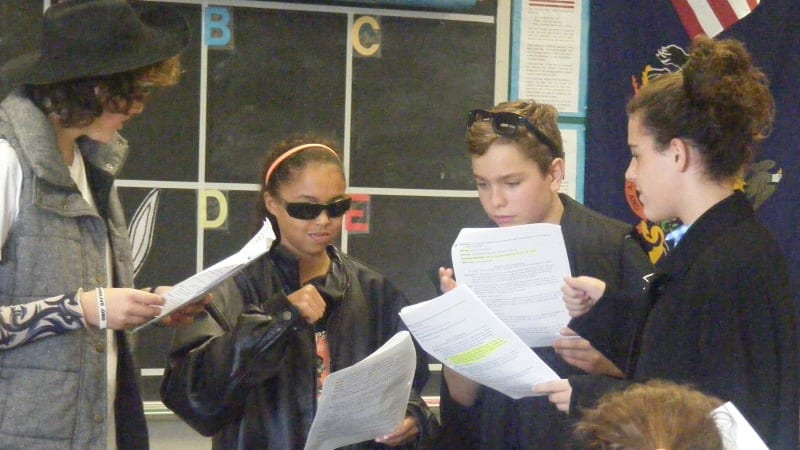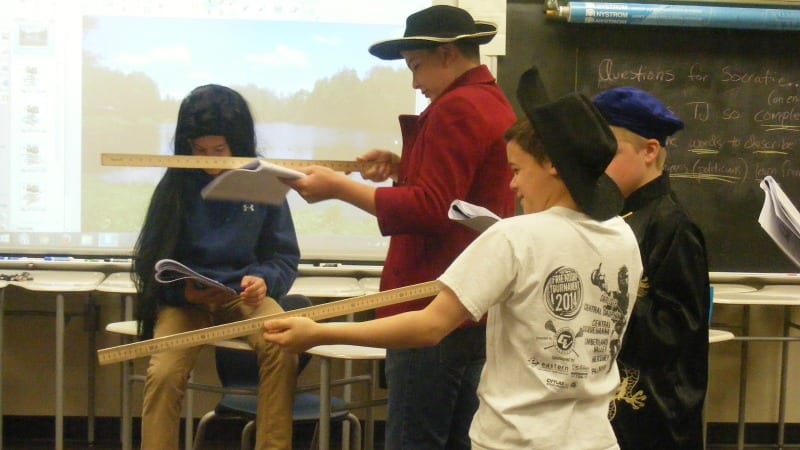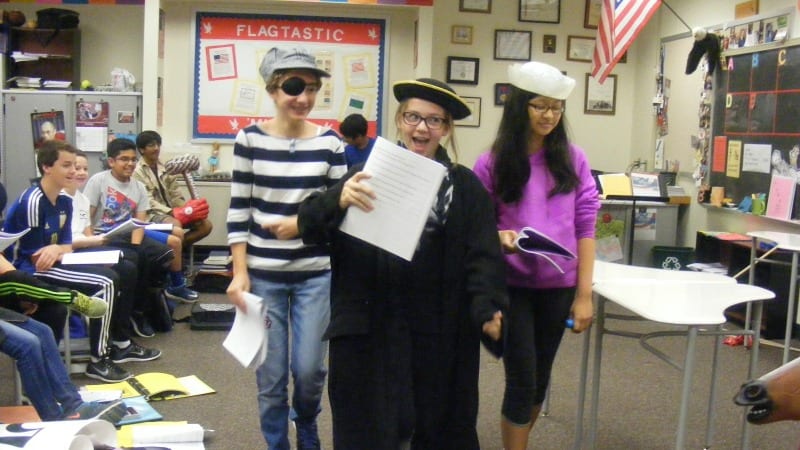Readers theater has changed the way I teach and the way my students learn. It’s kinesthetic and interactive. It’s about entertainment and great storytelling, two things sure to appeal to students in an age of social media and Netflix addiction. And best yet, it’s applicable to any age, ability, or content area. But not all readers theaters are successful. The best ones start with a great script.
I’ve written dozens of readers theater scripts over the years, and in doing so, I’ve learned plenty of lessons of what works and what doesn’t. I hope these tips help get you started with your own readers theater scripts. If you need more guidance, you can check out my readers theater scripts (including a freebie) in my Teachers Pay Teachers store.
1. Start with the lesson of your readers theater scripts in mind.

What do you want your students to learn? What topics do your students find lackluster that could benefit from a makeover?
When I realized many of my students were struggling to connect with the story behind the Declaration of Independance, I wrote “Declaration,” my first readers theater script. I wanted my students to get more out of Thomas Jefferson’s groundbreaking, defining words and realized the process of acting them out could help.
From major topics, such as the assassination of Archduke Franz Ferdinand, to forgotten tales, like The Scopes Monkey Trial, readers theater can breathe life, laughter, and learning into history or any other subject.
Before you start writing your readers theater script, decide what content you want to cover, what skills you want students to gain, and what your end goals are for the lesson. Then make sure you keep those important pieces throughout your writing.
2. Add the major characters.
Once you know what lessons and takeaways you want to cover, it’s time to decide on the characters. Ask yourself, “Who needs to be in the readers theater?” When writing “Declaration,” I wanted to ensure my cast of main characters was recognizable. I focused on John Hancock, Benjamin Franklin, John Adams, and, of course, Jefferson.
Just like any great movie script, there needs to be a balance in your dialogue. Too many “big characters” and it feels like the backstory from Lord of the Rings. Too few, and you’ve got Castaway. Keep your students involved and interested by selecting two to five mainstays in your readers theater script.
3. Construct a simple plotline.
In “Declaration,” students needed to learn that Jefferson’s Declaration had roots, so I built the introduction around the June 1776 Lee Resolution by Richard Henry Lee of Virginia. The plotline begins with Adams and Franklin reading the Resolution to one another, and then they take that idea to the Second Continental Congress. The movement towards independence then enters the Congressional chamber and it’s far from unanimous.
After those first tries, I learned to pare down my readers theater scripts. Know your grade and how long you can keep your students engaged. Keep in mind that each page of your script is about five to seven minutes of reading, depending on your students’ reading level.
4. Identify the tone.
Should your story be funny, dark, heroic?
“Declaration” is funny, as are most of my readers theater scripts. That’s because I enjoy the smile on students’ faces as we perform. However, the same approach cannot be taken for all readers theater scripts.
In my readers theater on Harriet Tubman, I wanted her to be lionized as a hero. With that in mind, I modeled her story around Batman.
Ask yourself this question: At the end of a readers theater, how do you want your students to feel? Your word choice, plotline, and dialogue should lead them there.
5. As you write, add supporting characters.

All of your students should have a role open to them in the readers theater, so you’ll need to add supporting characters.
In “Declaration,” I added John Dickinson and George Read as Statler and Waldorf-like Loyalist characters, peppering the independence movement with insults and dry humor. I added Roger Sherman to the cast when I learned he was one of the only founders to sign all four “great papers,” but I flexed some dramatic license and made him my comedic character who breakdances in the midst of Congressional debate.
Try to look for diverse roles in your supporting characters—women, people of color, those with special needs, as well as characters with diverse personalities. Often there are too many “lost” individuals in our curriculum that never made it into a textbook. Find those rare gems, and include their story. You might spur a kid to go home and explore more!
6. Get feedback.
It’s important to have someone in your content area read your readers theater scripts and provide feedback. Is it something he or she might want to use too? Does it fit the curriculum? I adopted this last important step and ask students and colleagues alike to provide suggestions with every reading.
Readers theater has given me a new way to introduce curriculum to my students, and it’s worked wonders. It’s amazing how dressing up and using props empowers students to be explorers, women’s right advocates, or the President of the United States. I plan to use readers theater for many years and content areas to come.
Check out Jake’s TPT store for his readers theater scripts, including a free version just for WeAreTeachers readers!

